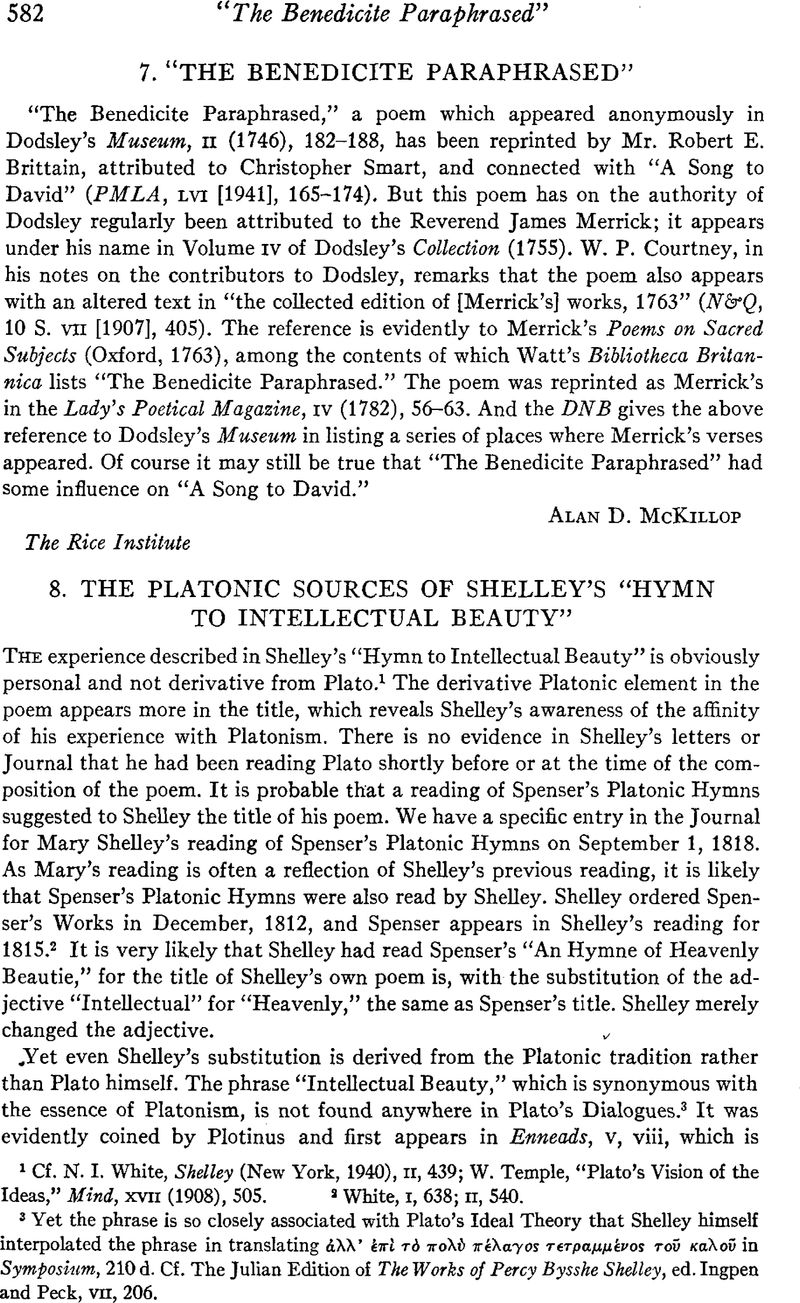No CrossRef data available.
Article contents
The Platonic Sources of Shelley's “Hymn to Intellectual Beauty”
Published online by Cambridge University Press: 02 December 2020
Abstract

- Type
- Comment and Criticism
- Information
- Copyright
- Copyright © Modern Language Association of America, 1943
References
1 Cf. N. I. White, Shelley (New York, 1940), ii, 439; W. Temple, “Plato's Vision of the Ideas,” Mind, xvii (1908), 505.
2 White, i, 638; ii, 540.
3 Yet the phrase is so closely associated with Plato's Ideal Theory that Shelley himself interpolated the phrase in translating ![]() in Symposium, 210 d. Cf. The Julian Edition of The Works of Percy Bysshe Shelley, ed. Ingpen and Peck, vii, 206.
in Symposium, 210 d. Cf. The Julian Edition of The Works of Percy Bysshe Shelley, ed. Ingpen and Peck, vii, 206.
4 Cf. C. Grabo, The Magic Plant (Chapel Hill, 1936), pp. 111, 248; for the opposite view, which the writer shares, cf. White, op. cit., ii, 597. The phrase “intellectual beauty” is not found in Thomas Taylor's translation of Plato. The closest parallel is “intelligible beauty,” cf. The Works of Plato (London, 1804), v, 719.
5 Letters of Percy Bysshe Shelley, edited by R. Ingpen (London, 1914), i, 372; cf. C. Van Doren, Life of Thomas Love Peacock (London, 1911), p. 56.
6 White, i, 276, 648 note 69.
7 Lord Monboddo, Of the Origin and Progress of Language (Edinburgh, 1773–1792), i, 105–106.
8 White, i, 701.
9 Histoire d'Agathon, traduction nouvelle et complète, faite sur la dernière éd. des œuvres … par l'auteur de Pietro d'Alby et Gianette [F. D. Pernay]. T. 1–3 (Paris: Maradan, 1801). Cf. T. J. Hogg, The Life of Shelley, edited by H. Wolfe (London, 1933), ii, 144.
10 White, i, 701; it may be of interest to note in Wieland's Agathon a brother-sister parallel to Loon and Cylhna. In this novel Agathon, a Platonic idealist, meets Psyche, who, as the name signifies, is the embodiment of Platonic love. Wieland skillfully has his lovers translate their Platonic love into a brother and sister relationship. Cf. C. M. Wieland, The History of Agathon, translated from the German Original (London, 1778), ii, 196–198.
11 T. J. Hogg, op. cit., ii, p. 145.
12 White, i, 701.
13 After an extensive search the writer was unable to locate a copy of Pernay's French translation. The English translation used here is C. M. Wieland, The History of Agathon, translated from the German Original (London, 1778), ii, 4.
14 Ibid., iii, 78.
15 Ibid., iv, 48–49.
16 Ibid., ii, 28, 178.
17 The Complete Poetical Works of Percy Bysshe Shelley, edited by Thomas Hutchinson (London, 1927), p. 203.
18 H. B. Forman, The Shelley Notebooks (St. Louis, Boston, 1911), i, 10.
19 R. Forsyth, The Principles of Moral Science (Edinburgh, 1805), p. 283.
20 Ibid., p. 514.
21 Cf. White, ii, Index, cviii–cxii.
22 Ion, 533 D–E.




